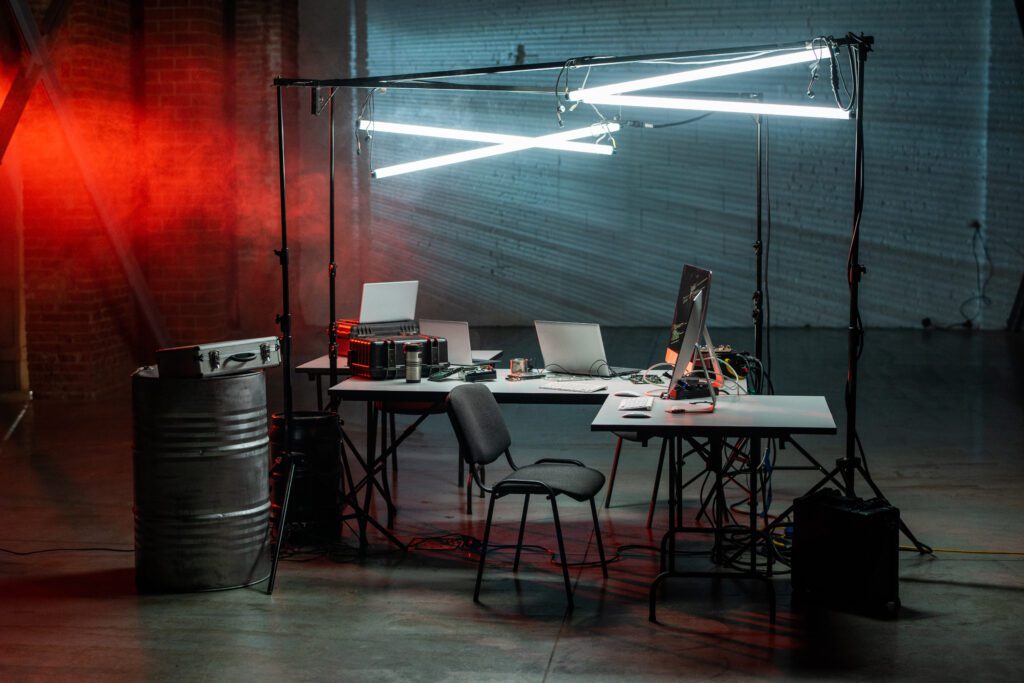Hey there! So you’ve swapped your stylish office suit for comfier sweatpants and embraced the home office life, huh? Well, there’s nothing quite like the freedom of working from your own space, with unlimited coffee breaks and no one to steal your lunch from the fridge. But if your lighting scenario is, dim looking little it’s time to brighten up your workspace. After all, no one likes squinting at their computer screen, right?
Don’t worry. As a seasoned home office veteran and a dad slotting in work hours between dance recitals and soccer games, I’ve got you covered with insider tips to transform your home office into a beacon of productivity. Trust me, correct lighting has more power than just avoiding stubbing your toe on that stray Lego piece!
Remember: “The right lighting can improve your mood, reduce eye strain, and even make that hideous wallpaper look a little better!”
So, curious about how to make your workspace shine bright like a diamond?!
Let’s dive into the nitty-gritty of:
- Assessing your current lighting situation
- Choosing the perfect task-lighting
- Creating a layered lighting plan
- Shedding light on picking the right lightbulbs
- How to place your lights to minimize glare and shadows
- Incorporating aesthetics into your lighting plan
- Adjusting your lighting for daytime and nighttime
- Energy-efficient lighting options for your eco-conscious home
And no, you won’t need a degree in advanced physics to figure this out. I promise your path to a perfectly lit home office is easier than assembling Swedish flat-pack furniture! So buckle up your office chair, and let’s get started.
Table of Contents
Assessing Your Current Lighting Situation: Shedding Light on the Issues
Natural light is beneficial for a home office as it can boost mood and energy levels.
Just like you wouldn’t start a home renovation without assessing what you’re working with, you shouldn’t start revamping your home office lighting without a good, hard look at the status quo. So, grab a cup of coffee (or maybe something stronger), because it’s time to start taking inventory.
Begin by turning off all the lights in your office during the day. How’s the natural light? If it’s throwing shadows on your work, it might be time to invest in some window coverings. You could even try rearranging your desk so that light falls over your shoulder, rather than glaring onto your screen. And if you’re working from a windowless basement and the sunlight situation is a consistent ‘zero’ — don’t despair. We’re going to tackle artificial lighting next.
Now, switch on your artificial lights one by one. Note how they affect your space. It’s time to ask yourself some questions about each light source. Is the light too bright? Too dim? Are there shadows obscuring your workspace or glaring spots from unfiltered light? If you answered ‘yes’ to any of these, it could be a sign that your current bulbs aren’t right for the job.

It’s also important to consider the type of work you’re doing under each light. Fine detail work, like drawing or writing, needs a direct task light with a bulb that mimics natural daylight. However, if you’re primarily on your computer, you’re going to want to avoid overly bright lights to minimize screen glare.
Lastly — and this is a biggie — consider whether your current lighting situation is adding or detracting from your work environment’s general ambiance. If your lights make your office feel like an interrogation room rather than a cozy workspace…well, then I think we’ve identified the root of that 3 p.m. energy slump.
Well done, scout! You’re one step closer to creating the ideal home office lighting set-up. Next, we’ll move on to choosing the right lighting for specific tasks.
Let There Be Task Lighting: Illuminating the Path to Productivity
Proper lighting can enhance creativity and inspiration in a workspace.
Alright, now that we’ve done some self-reflection on our current lighting situation, let’s dive into the heart of the matter – task lighting. Now, you might be wondering, “What on earth is task lighting?” Well, my dear reader, prepare for enlightenment! (Pun absolutely intended).
Task lighting, in essence, is focused, adjustable illumination that supports you in getting specific tasks done. Whether it’s reading a document, manipulating small tools, or just finding that elusive secret snack stash, task lighting informs your eyes directly where to look.
Now, why does task lighting matter in terms of productivity? Let’s say you are working on a detail-oriented task. The last thing you want is to strain your eyes, right? Not to mention, a well-lit workspace dramatically reduces the likelihood of mistakes. The less time you spend squinting or fixing blunders, the more tasks you’ll accomplish. So yes, good task lighting can take productivity to new heights (or brightness, in this case).
Remember, folks, task lighting is like Batman’s spotlight signaling him into action; it directs your attention right where you need it for maximum effectiveness.
Choosing the Right Task Lighting
We all have different tasks in our day-to-day work life. Consequently, our lighting needs may also vary. Here’s a brief guide to help you choose the right task lights:
- Focused Desk Lamps: Opt for lamps that easily adjust and direct light where you need it. Those with swing-arm designs are a great choice. Additionally, desk lamps with strong LED bulbs offer clear and bright light.
- Under-Cabinet Lights: If your home office includes cabinets or shelves above your work area, consider installing under-cabinet lights. They provide excellent task lighting, especially for keyboard tasks.
- Overhead Pendant Lights: Hanging lights directly over your workspace, not only contribute to the style, but they are also excellent task lights. Just ensure the bulbs are bright enough and the pendant is hanging at the right height.
Now, how about we layer this task lighting with your ambient lighting to create a brilliant, productive workspace? Let’s move on to the next section where we’ll dissect the art of crafting a layered lighting plan.
Creating a Layered Lighting Plan: The Magic of Illumination

Alright, you’ve gotten your feet wet with assessing your current situation and considering task lighting. But my friend, you’re just getting started. Now, let’s dive into the exciting world of layered lighting and explore the full magic of illumination. Trust me, it’s not as complicated as it sounds; think of it like making a sandwich. Except in this case, the sandwich illuminates your workspace, which, let’s be honest, is a lot more exciting.
Now, layered lighting is pretty much what it says on the tin – layers of light. But why layer your lighting, you ask?
Consider this – every task and mood requires different types of lighting. The soft, ambient glow for a late-night brainstorming session may not cut it when you’re trying to read the small print on a document in the morning. That’s where having a layered lighting plan comes into play.
The key here is to blend different types of light sources – general, task, and accent lighting – so you can adjust your home office lighting according to your needs at any given time. Sounds like a magic trick, right?
General Lighting
First up, we have general lighting. This light sets the tone for your workspace, providing a uniform level of illumination throughout the room. It’s kind of like background music for your day but in the form of light. Overhead fixtures or ceiling-mounted lights often serve as general lighting.
Task Lighting
Next is task lighting, our spotlight superstar. Task lighting shines a light on specific work areas where you need a bit more brightness, like your desk, reading nooks, or other essential spots. Desk lamps, under cabinet lights, or track lights make excellent task lights.
Accent Lighting
And finally, we have accent lighting – the spice of your lighting sandwich (excuse the food reference, but a man’s got to eat!). Use accent lighting to highlight specific features in your home office like artwork, bookcases, or architectural elements. Think spotlights, wall-mounted fixtures, or LED strip lights.
So, there you have it. A layered lighting plan. Now, I hear ya, this does feel like putting a lot of thought into lighting, but isn’t carving out a comfortable, functional, and well-lit home office space worth the effort? Plus, creating a layered lighting plan is just a fancy term for giving yourself lots of light options.
Well then, ready to dive into the next stage and choose the perfect lightbulbs for your space? Let’s light this candle!
Choosing the Right Lightbulbs: Shedding Light on the Brightest Options
So, you’ve assessed your current lighting, decided on some task lighting, and even planned a layered approach. Good on you! But now comes a tricky bit – choosing the right lightbulbs.
Before anyone starts thinking, “Come on, it’s just a bulb,” let me tell ‘ya – it’s more than you think. Consider this: Would you sport sunglasses in a movie theater or whip out bright stadium lights for a cozy dinner? It’s all about the right light for the situation, my friend.
The Watts and Lumens
First things first, let’s clear up the difference between ‘watts’ and ‘lumens’. Watts describe the amount of energy your lightbulb uses, while lumens tell us about the brightness. So, when you’re shopping for bulbs, keep an eye on those lumens. More lumens? Brighter bulb. Simple.
Type of Bulb
Next up, is the bulb type. Nowadays, we’ve got our pick of the litter – from the ol’ fashioned incandescent to the long-lasting LED, energy-saving Compact Fluorescent Lamps (CFLs), and high-quality Halogen lights.
- LED: These hardy little champs last a good long while and don’t guzzle electricity. Plus, they don’t give off too much heat. A little pricier upfront, but they’ll save you in the long run. Good for the task and general lighting.
- Incandescent: Your regular Joe of light bulbs. Cheap and available everywhere. Gesture of caution though – they don’t last as long and aren’t as energy-efficient as their brethren bulbs.
- CFL: These guys last longer than incandescent bulbs and are more energy-efficient. However, they do contain a smidge of mercury, so handle it with care!
- Halogen: This is the crema for your espresso. For when you want the quality of light to truly shine. These bulbs are great for accent lighting.
Color Temperature
Lastly, let’s chat about color temperature. You might’ve seen it on the packaging as ‘Warm White’, ‘Cool White’, or ‘daylight’. Warm light can be great to create a cozy atmosphere, while cool light can help you focus – perfect for those spreadsheets and reports. And ‘daylight’? Well, it’s meant to replicate, you guessed it, natural daylight.
Remember, there’s no ‘one size fits all’ solution here. It all depends on you, your workspace, your tasks, and your personal preferences. Try out a few options before you settle on your perfect bulb.
With the proper lights, your bulbs will brighten your workday (yes, again, pun intended), save you some cash, and make your home office a place where productivity meets comfort. Now, doesn’t that sound enlightening?
Banishing Glare and Shadows: Lighting Tricks to Enhance Focus
No matter how premium your light bulb or fancy your lamp shade, without the right positioning, you’re just setting yourself up for an all-you-can-eat buffet of glare and shadow monsters. Trying to decipher your kid’s scribbles on the Excel spreadsheet under sub-par lighting isn’t exactly a walk in the park, right? In this section, I’ll share some tricks to help you banish those pesky shadows and glares for good.
Where are the shadows coming from?
First and foremost, you need to play detective—identify where those sneaky shadows are coming from. Turn on your lights, take a seat at your desk, and look around. If your window is on the side, does the natural light create awkward darkness across your workspace? How about that desk lamp: is it throwing a shadow across your keyboard? It’s about observing your current setup and acknowledging all the peek-a-boo spots for the shadowy culprits.
Shoo, away the glare.
Now, onto the glare. There’s nothing more distracting than trying to squint through a sun-blinding glare on your screen. Check to see if your monitor is in the direct line of a light source—be it a window, desk lamp, or overhead fixture. If you’re constantly feeling like you’re looking into the headlights of an oncoming car, it’s time to switch things up.
Light positioning: The superhero we need.
Light positioning is the unsung hero in our quest to eliminate glare and shadows. Here are some general rules of thumb:
- Desk lamp: Align it to the opposite side of your writing hand. This way, you can avoid casting shadows on what you’re working on.
- Overhead lights: These should fill the entire room without casting shadows. If your overhead light is a spotlight of drama, consider swapping it out for a fixture that disperses light more evenly.
- Monitor placement: Your monitor should be perpendicular to your window. It prevents external natural light from creating glare on your screen.
Bouncing light:
Here’s another superhero trick—bouncing light. If your space is dark, and you’ve done everything you can with your light sources, you can use mirrors, light-color walls (think soft pastels or whites), or glossy surfaces to bounce light around and increase ambient illumination. Just make sure not to direct it towards your screen and trigger a glare apocalypse!
So there you have it! By identifying shadow and glare sources, repositioning your lights, and playing with light reflection, you can enhance your focus, reduce eye strain, and become the lighting superhero your home office needs. Remember, the battle against bad lighting is one we can all win. Onward to victory!
Shine a Light on Your Style: Incorporating Aesthetics into Your Lighting Plan

Alright, sit down, and let’s have a chat about the fun part – aesthetic. Sure, functionality is fantastic (and vital), but can we agree that things should also look good? Would you wear something that fits but makes you look like you’ve abandoned style altogether? No, right? The same philosophy applies to your home office lighting. When selecting fittings, lamps, or even bulbs, let’s make sure we’re adding some flair to your workspace. After all, style matters!
Your lighting choices should ideally echo your style and the existing decor of your workspace. If you’re a minimalist, maybe a sleek LED desk lamp would be just the ticket. Got a classic vintage taste? A brass table lamp could be your jam. The idea is to create a space that both lights up your tasks and your unique sense of style. Ready to sparkle up your workspace? Let’s dive in!
Choosing Lighting Fixtures
Let’s start with lighting fixtures. They’re like the eyeglasses of your workspace – combining both function and style. You’d want something that illuminates your workspace effectively and looks pretty darn cool. Pendant lights, wall sconces, desk lamps, or floor lamps – the choices are endless. But remember, they have to match your workspace style. If you’re not sure, a black, white, or metallic finish is usually a safe bet. It’s quite amazing how a unique lighting fixture can significantly elevate the look of your office, isn’t it?
Layering Your Lights with Style
Next up is layering your lights stylishly. Sure, we’ve talked about layering for functionality, but what about layering for aesthetics? This might sound fancy, but it merely involves arranging your light sources (your stylish lighting fixtures, of course) in a way that not only aids vision but also adds depth, shadow, and interest to your workspace. An overhead light, a task light, and some accent lights creatively placed can make your office look like it’s ready for a magazine feature.
Expressing Your Mood with Lighting
Ever walk into a room and feel instantly relaxed or energized? Yep, that’s mood lighting working its magic. With the right light color temperature, your workspace can mimic those vibes too. Warm light can help create a cozy, relaxing mood, while cooler light is usually more energizing. If you want the best of both worlds, some lightbulbs offer adjustable color temperatures. Impressive, right? Now go forth, and add some serious style vibe to your workspace. After all, who doesn’t love a workspace that’s both productive and drop-dead gorgeous?
Daytime vs. Nighttime: Adjusting Your Lighting for Optimal Work Conditions
Would you believe me if I told you that your productivity could be influenced by the time of day you’re working? Bet you wouldn’t see that plot twist coming – not in an office lighting guide, anyway. Jokes aside, working in broad daylight versus late-night shifts can and does influence your lighting requirements. Let me fill you in with the lowdown on how you can optimize your lighting for both day and night scenarios for maximum work efficiency. Intrigued? Excited? Nervous? Keep calm and let’s shed some light on the matter.
The Daylight Conundrum: Dealing with Natural Light
Offices drenched in natural daylight are all the rage these days, and for good reason. Exposure to sunlight makes us feel happier (thanks, serotonin!) and can boost our productivity. If you’re working during the day, try positioning your workspace near windows to take advantage of that all-natural, mood-enhancing luminescence that Mother Nature graciously provides for free.
But, hold on a second, what happens when sunlight is too intense and creates glare on your laptop screen or important documents? The struggle is real, friends, and the solution is equally tangible – use window coverings! Choose blinds or curtains that allow you to control the amount of light entering your workspace. Another neat tip? Try arranging your monitor perpendicular to the window to alleviate screen glare while still enjoying the sunshine.
Nighttime: The Art of Combating Darkness
When it comes to working at night, we need to fight off the encroaching shadows with adequate artificial lighting. However, too much light can make your workspace feel like an interrogation room which, unless you’re really into crime dramas, isn’t conducive to a productive work environment.
The trick here is to establish a balance. Ensure your general lighting gives enough light to navigate the room while you provide focused task lighting for your work area. Warm light with a color temperature in the range of 2700 to 3000 kelvins can be a good pick for night work as it is relaxing yet bright enough for work. And remember, those pesky shadows can creep up from any corner, so strategic lamp locations are a must. When in doubt, bounce light off of walls or ceilings to disperse it evenly.
Finally, don’t forget to take regular breaks from your screen – especially at night, to reduce eye strain caused by looking at the harsh screen light for too long. Trust me, your eyes will thank you for it!
And there you have it, folks – day and night lighting mysteries, solved! Has your trip through this labyrinth of lighting enlightenment made you rethink your workspace setup yet?
Bright Ideas: Energy-Efficient Lighting Options for Eco-Conscious Homes
Have you ever wondered if you could brew a pot of coffee or charge your smartphone with the electricity you consume in your home office each day? Unfortunately, we’re not quite there yet. However, wouldn’t it be great to send some of that renewable ‘light juice’ back into your daily pot of productivity? It’s a challenge I’m willing to tackle. So, let’s dive into some bright ideas for energy-efficient lighting that can benefit not only your wallet but also Mama Earth.
First things first, let’s bust the myth that energy-efficient lights lack the oomph of traditional bulbs. These are not the bluish, dim lights that you may be imagining. We’ve ushered in a new era of energy-efficient bulbs that are strong contenders in the office light ball game.
Go Green with LED
LEDs, or light-emitting diodes, are no longer visitors from the future. They’re here, and they’re here to stay. Why? Because they last 25 times longer than traditional incandescent bulbs and consume about 75% less energy. Talk about maximizing output with minimal input!
The CFL Club
Next in line are Compact Fluorescent Lights (CFLs). These might look a little odd with their spirals and tubes, but don’t let that fool you. They last about 10 times longer than incandescent lights and use 60%-80% less energy. Being quirky can pay off sometimes!
Introducing… Halogen Incandescent!
Halogen incandescent, the kinder siblings of the traditional incandescent light, are another great option. While they don’t score as high as LEDs or CFLs, they’re still about 25% more efficient than traditional bulbs. So, if you want to keep the familiar shapes and light quality but with a more eco-friendly touch, halogen incandescents could be your perfect match.
Remember, every lumen you light up contributes to your overall electricity consumption. By choosing energy-efficient options, not only do you reduce your utility bills, but you also do your bit for our planet. So here’s to shining a light on better options – they’re worth the switch.
Conclusions
Alright, there we have it, my enlightened friends! All the tips and tricks that have helped me turn my home office from a dimly lit pain cave into a veritable powerhouse of productivity and inspiration. Here’s a quick recap before we bid adieu:
- Assess your current lighting: Understand your space, needs, and what you’re currently working with.
- Choose purposeful lighting: Task, ambient, and accent lighting should all play a part in your strategy.
- Embrace a layered approach: Lighting needs to be dynamic, not static. Different tasks and times of day will require different lighting setups.
- Choose the right lightbulbs: CFLs, LEDs, or Halogens. Understand the pros and cons of each and which one fits your needs the best.
- Placement is key: Minimize glare and shadows by positioning your lighting sources correctly.
- Create a productive and inspiring ambiance: Effective lighting can definitely up your work-from-home game. But remember, it’s all about what works for you.
And finally, let’s not forget our good old common sense. Because lighting up any room is as much of an art as it is a science. Each space has a unique character, and the lighting should complement that. It’s nothing to be afraid of. Experiment, enjoy it, and create something special that will inspire you to do your best work.
“In the right light, at the right time, everything is extraordinary.”–
Aaron Rose

Leave a Reply